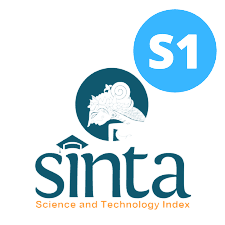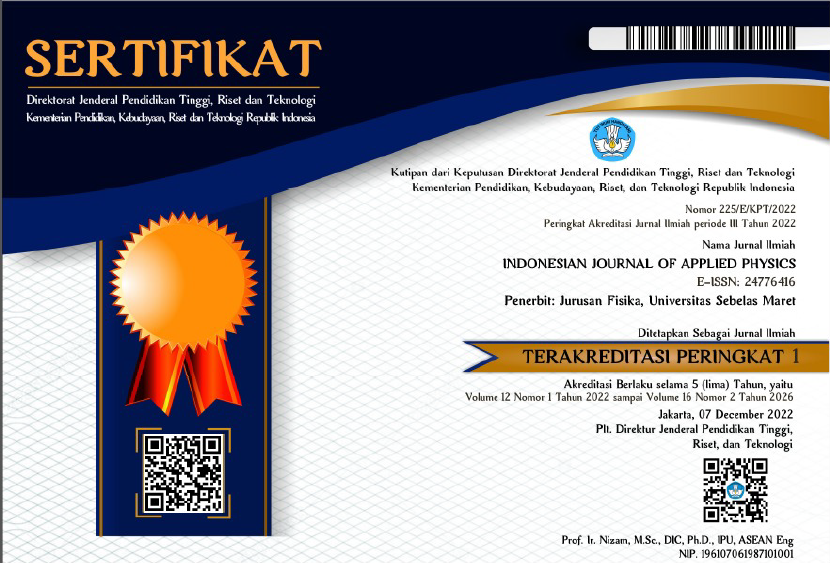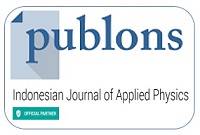Surface Area Analysis of Activated Carbon Material From Palm Frond Waste using Different Activation Agents
Abstract
Carbon is one of the abundant elements obtained from organic matter, one of which is found in the fronds of oil palm trees which is found on the Kalimantan Island. This research uses local organic waste in East Kalimantan to be used as activated carbon material, palm frond waste. Activated carbon material is one of the materials that has a high surface area and is widely applied for adsorbent materials. This study aims to analyze and compare the surface area of activated carbon synthesized from palm frond waste using different activating agents. This research also analyzes the nature of the material structure, surface area, pore size and pore volume of activated carbon. The method used is the process of thermal activation and chemical activation to convert carbon into activated carbon with variations of activating agents, phosphoric acid (H3PO4) and sodium hydroxide (NaOH). XRD, BET-SAA and SEM-EDX characterization tests were conducted. The results obtained show that the amorphous structure of activated carbon has been formed and there is an increase in BET surface area due to the activation process. The surface area obtained for the Non-Activated Carbon (C) sample is 15,149 m2/g, Activated Carbon-NaOH (AC-1) is 2,082 m2/g, Activated Carbon-H3PO4 (AC-2) is 307,692 m2/g. This shows that the best sample with the highest surface area is the AC-2 sample which uses the H3PO4 chemical activator solution.
Keywords
Full Text:
PDFReferences
1 Hermanto, H., Heryadi, E., & Susanty, A. 2021. Potensi Biogas dari Limbah Padat Industri Kelapa Sawit di Kalimantan Timur. Jurnal Riset Teknologi Industri, 487-497.
2 Muhdarina, M., Nurhayati, N., Pahlepi, M. R., Pujiana, Z., & Bahri, S. 2020. Penyiapan arang aktif pelepah kelapa sawit sebagai adsorben asam lemak bebas dari CPO (Crude Palm Oil). al Kimiya: Jurnal Ilmu Kimia dan Terapan, 7(1), 7-13.
3 [Achmad, R., Fauziah, S., & Zakir, M. 2020. Pembuatan dan Modifikasi Karbon Aktif Pelepah Kelapa Sawit (Cocus nucifera L.) Sebagai Adsorben Metilen Biru (Preparation and Modification Of Activated Carbon from Palm Oil (Cocus nucifera L.) As Adsorbent Of Blue Methylene). Indonesian Journal of Pure and Applied Chemistry, 3(2), 1-10.
4 Yu, C., & Han, X. 2015. Adsorbent material used in water treatment-a review. In 2015 2nd International Workshop on Materials Engineering and Computer Sciences (pp. 286-289). Atlantis Press.
5 Bakti, A. I., Harianto, Y. A., & Nugraha, M. K. 2022. KARAKTERISASI KARBON AKTIF YANG TERBUAT DARI TEMPURUNG KELAPA DENGAN AKTIVASI Na2CO3 DAN SUHU 1000 oC MENGGUNAKAN TEKNIK XRD DAN SEM-EDX.
6 Sujiono, E. H., Zabrian, D., Zharvan, V., & Humairah, N. A. 2022. Fabrication and characterization of coconut shell activated carbon using variation chemical activation for wastewater treatment application. Results in Chemistry, 4, 100291.
7 Mojoudi, N., Mirghaffari, N., Soleimani, M., Shariatmadari, H., Belver, C., & Bedia, J. 2019. Phenol adsorption on high microporous activated carbons prepared from oily sludge: equilibrium, kinetic and thermodynamic studies. Scientific Reports, 9(1), 19352.
8 Shamsuddin, M. S., Yusoff, N. R. N., & Sulaiman, M. A. 2016. Synthesis and characterization of activated carbon produced from kenaf core fiber using H3PO4 activation. Procedia Chemistry, 19, 558-565.
9 Al-Swaidan, H. M., & Ahmad, A. 2011. Synthesis and characterization of activated carbon from Saudi Arabian dates tree’s fronds wastes. In 3rd International conference on chemical, biological and environmental engineering (Vol. 20, pp. 25-31).
10 Anita, S., Hanifah, T. A., & Kartika, G. F. 2023. Preparation and characterization of activated carbon from the nipa fruit shell irradiated by microwave: effect temperatures and time of carbonization. Materials Today: Proceedings, 87, 390-395.
11 Maulina, S., Handika, G., Irvan, I., & Iswanto, A. H. 2020. Quality comparison of activated carbon produced from oil palm fronds by chemical activation using sodium carbonate versus sodium chloride. Journal of the Korean Wood Science and Technology, 48(4), 503-512.
12 Zayed, A. M., Metwally, B. S., Masoud, M. A., Mubarak, M. F., Shendy, H., Petrounias, P., & Wahed, M. S. A. 2023. Facile synthesis of eco-friendly activated carbon from leaves of sugar beet waste as a superior nonconventional adsorbent for anionic and cationic dyes from aqueous solutions. Arabian Journal of Chemistry, 16(8), 104900.
13 Heryanto, H. 2025. Rice husk-derived biosilica/clay hybrids for photocatalytic dye degradation. Materials Chemistry and Physics, 332, 130245.
14 Gupta, M. K., Sinha, N., & Kumar, B. 2010. Synthesis and comparative study of ZnO nanorods for structural, optical and dielectric behaviour. Integrated Ferroelectrics, 118(1), 61-66.
15 Shrestha, D., Maensiri, S., Wongpratat, U., Lee, S. W., & Nyachhyon, A. R. 2019. Shorea robusta derived activated carbon decorated with manganese dioxide hybrid composite for improved capacitive behaviors. Journal of Environmental Chemical Engineering, 7(5), 103227.
16 Arundina, R. Y., Permana, I., Togatorop, E. R. S., Ismadi, I., Kusumah, S. S., Budiman, I., ... & Marlina, R. 2021. Synthesis and characterization of activated carbon from lignocellulosic biomass: oil palm empty fruit bunches and mahogany sawdust. Jurnal Bahan Alam Terbarukan, 10(2), 81-88.
17 Hardi, A. D., Joni, R., Syukri, S., & Aziz, H. 2020. Pembuatan Karbon Aktif dari Tandan Kosong Kelapa Sawit sebagai Elektroda Superkapasitor. Jurnal Fisika Unand, 9(4), 479-486.
18 Heryanto, H., Tahir, D., Abdullah, B., Kavgaci, M., Rinovian, A., Masrour, R., ... & Sayyed, M. I. 2024. Carbon as a multifunctional material in supporting adsorption performance for water treatment: Science mapping and review. Desalination and Water Treatment, 100758.
19 Heryanto, H., Tahir, D., Abdullah, B., Setiawan, V., Partini, J., Ilyas, S., ... & Merita, M. 2024. IoT real-time monitoring system implemented to observe sunlight-influenced methylene blue degradation by AC/HAp. Environmental Science and Pollution Research, 1-15.
20 Bakti, A. I., & Lumembang, M. M. 2023. KARAKTERISASI KARBON AKTIF YANG TERBUAT DARI TEMPURUNG KELAPA MENGGUNAKAN TEKNIK PIROLISIS DENGAN AKTIVASI FISIKA DAN KIMIA. Jurnal MIPA, 12(2), 56-60.
21 Wibowo, S., Syafi, W., & Pari, G. P. 2011. Karakterisasi permukaan arang aktif tempurung biji nyamplung. Makara Journal of Technology, 15(1), 150718.
22 Kumar, A., & Jena, H. M. 2016. Preparation and characterization of high surface area activated carbon from Fox nut (Euryale ferox) shell by chemical activation with H3PO4. Results in Physics, 6, 651-658.
23 Kumar, A., & Jena, H. M. (2016). Preparation and characterization of high surface area activated carbon from Fox nut (Euryale ferox) shell by chemical activation with H3PO4. Results in Physics, 6, 651-658.
24 Ali, R., Aslam, Z., Shawabkeh, R. A., Asghar, A., & Hussein, I. A. (2020). BET, FTIR, and RAMAN characterizations of activated carbon from waste oil fly ash. Turkish journal of chemistry, 44(2), 279-295.
25 [Nurdin, A., Iriani, I., Harahap, H., & Fahmi, A. 2022. Production Process of Large Pore Size Activated Carbon from Palm Kernel Shell using Sodium Chloride as An Activator. Indonesian Journal of Chemical Research, 10(1), 8-13.
26 Patmawati, Y. 2022. Mengenal permukaan karbon aktif batu bara. CV Literasi Nusantara Abadi.
27 Feng, P., Li, J., Wang, H., & Xu, Z. 2020. Biomass-based activated carbon and activators: preparation of activated carbon from corncob by chemical activation with biomass pyrolysis liquids. ACS omega, 5(37), 24064-24072.
Refbacks
- There are currently no refbacks.
















